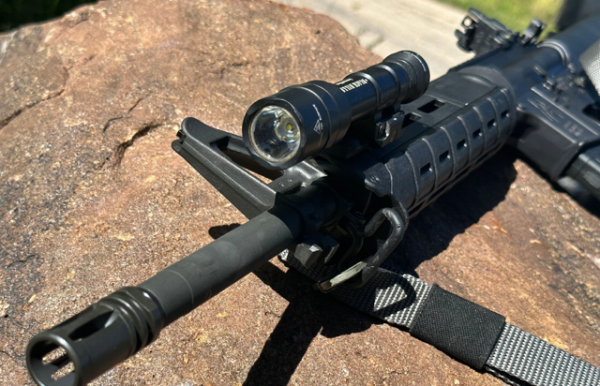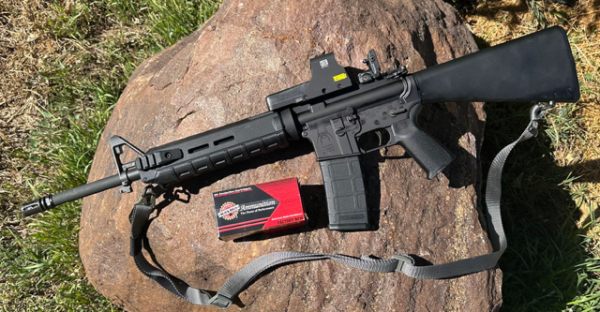
If I had to put an approximate time stamp on it, I would say that we “jumped the shark” with the black rifle (or AR-15 if you like) about the time manufacturers started drilling holes in bolt carriers to “lighten them up”. This, of course, was paired with aftermarket buffers and buffer springs to mate with the new super light bolt carriers.
The other major offenders are the companies producing “competition brakes” to “control the recoil of the .223 Remington”. Brothers and sisters, if you are having an issue controlling the recoil of the .223 Remington cartridge in anything but a derringer, you need to eat your Wheaties and pick up some steel. I have trained 105 pound women to run an M4 with no special modifications added to it.
While I generally dislike the term “tacticool” and have rarely, if ever, used it, in this circumstance it seems to fit the situation in which we now find ourselves in regard to using the AR style rifle as a home defense tool. There is far too much confusion regarding what accessories are practical and useful and which ones are useless at best and dangerous in the worst case.
Whether we are discussing a handgun, shotgun, or rifle, the most important consideration for a tool with which we are planning to save our lives and the lives of family members is reliability. With very few exceptions, in our modern world, the farther you stray from factory specifications, the more likely you are to reduce the reliability of said firearm.
Yes, I was alive during the era where, if you wanted your M1911 to reliably feed a variety of ammunition, you needed to have some work done to it by a trained gunsmith. Folks, it is not 1982 anymore. The firearms coming off the factory lines are made with quality control that was unheard of 20 or 30 years ago.
Granted, there may be some discount, bargain basement rifles that are not quite up to par. However, we need to insert an intellectual honesty check here. If you think paying $499 for an AR style rifle in the 21st will get you a robust and reliable fighting tool, you are lying to yourself. A good price for a Colt AR-15 in 1985 was $500. I recall drooling over just such a gun when I was making $4 an hour and $500 was about all I took home each month after taxes.
Ask any engineer and they will tell you the more moving parts you add to a machine, the more likely it is that something will go wrong. The more you monkey with your black rifle by adding aftermarket parts, the less reliable it will eventually become.
You may have noted that reliability and function are listed separately and placed before accuracy. By function, I mean the ability of the user to make the machine work, not in just the best of circumstances, but in the worst of circumstances. The home defense rifle should be one that can be operated readily, not just by the Alpha male of the household but by every responsible adult therein.
The controls on the modern AR-15 are purpose built having been based upon rigorous field testing that took place over years. Oversized and ambidextrous aftermarket controls may seem like good ideas at first glance. Nonetheless, in practical application, under rigorous use, oversized/ambidextrous controls tend to activate or deactivate when they are not supposed to, catch on clothing, gloves, etc. and break because they are structurally weak.
Additionally, from a tactical standpoint, training only with specially modified guns puts the end user at a disadvantage. If they are ever called upon to use a stock rifle that does not have ambidextrous or extended controls, their muscle memory will not be there.
Lightweight aftermarket triggers are fine for slowfire, target use. They have no business on a home defense rifle. The trigger press on a self-defense gun must always be deliberate, not unintentional because it is tuned to 1.75 pounds.
We are living in the zenith of barrel/chamber manufacturing. The rifles rolling off of the assembly line today have more inherent/built-in accuracy than 99% of the end users can ever hope to realize.
Remember, the sights or optics installed on the rifle don’t make the gun “more accurate”. Sights and optics are there to help the user align their shooting eye with the bore of the rifle.
New rifles or new sight/optic setups need to be taken to the range and the true zero confirmed. You need to have confidence that the bullets will go where you expect them to. Practical BZO (battle sight zero) for a home defense tool is 25 yards.
Having carried a black rifle in some form or fashion since I was issued an M16A2 in 1987, I naturally have strong opinions as to what makes one practical and what makes them not so.
During a conversation with my friends at Spikes Tactical, the question was raised, “What would you put on a rifle that was purpose built for home defense?”
My response to that inquiry was to create a well-thought out laundry list of Do’s and Don’ts for such a tool. To this list I applied the previous criteria; Reliability, Function, Accuracy. The home defense rifle must be robust and reliable. There are parts, to include the bolt carrier group, buffer system and trigger, that must be high quality and meet or exceed MilSpec. On a fighting gun, there is no room for competition parts.
As for furniture, we keep it simple and robust. The stock is a fixed M16A1 length version. Home defense guns do not need infinitely adjustable stocks. My beloved Corps erred when they lengthened the M16 stock, the A1 length is the right one. Aluminum rail systems are unnecessary for our home defense gun and they add weight and cost to the end unit.
The forend of what would become the Lexington & Concord Rifle is the Magpul MOE version with a cantilever mount installed for the addition of a white light. The pistol grip is the Magpul version, it is not fancy, it is tough and functional.
Decades of shooting black rifles have shown that if you are going to use a Non-NFA, 16 inch barrel, the midlength gas system is superior to the short length. A short gas system is truly only needed when the barrels shrink. The average American citizen doesn't need or want to file NFA paperwork for a home defense rifle, therefore 16 inch barrels are the way to go. On the business end of the barrel is the A2 flash hider / compensator, a tried and true design.

The front sight housing is the traditional A frame. A tritium front post and cantilevered SureFire Scout light rounds out the Lexington & Concord equipment list.
The front sight housing is the traditional A Frame. This design is sturdy. In the front sight housing we chose to make an upgrade from the thin steel post. The front sight is the most important one and finding it in all light conditions, even with aging eyes, is paramount. We decided to go with a Tritium AR-15 front sight from Night Fision. This sight has the 1 ⁄ 4 click adjustments for proper zeroing and the Tritium is surrounded by super bright “safety green” translucent polymer.
Every rifle should have a sling. We partnered with Galco to add their SLC Strap to the L&C rifle package. The SLC Strap is simple and effective. A standard capacity magazine from Magpul is shipped with every rifle.
A flat top upper receiver is used in anticipation of the end user installing some type of optic. However, the rifle is ready to go out of the box because a Magpul BUIS rear sight is mated with the front sight.

The Lexington & Concord version of the AR-style rifle: everything necessary to defend the home in a dependable package. One key element isn’t shown, but not optional: training.
As mentioned earlier, the ability to mount a white light to a home defense rifle is not just a nice feature, it is an imperative. Responsible citizens are required to identify their potential target. We cannot justifiably shoot at shadows or in the direction of scare noises. Are you dealing with a home invasion or an unexpected relative? You need light.
The FBI tells us that at least half of all violent attacks occur in darkness or poor light conditions. You are just as likely to use your home defense rifle in the dark as you are in the daytime. A bright white light, mounted securely to your rifle is the tool you need to identify genuine threats. The L&C rifle does not ship with a light, but my choice for a reliable light is the SureFire Scout model.
Once more, whether a pistol, shotgun, or rifle, the key to success is training and practice. We train so that we can learn how and what to practice. Training also builds the genuine confidence in your skills that you will need during what Mas Ayoob dubbed “the Gravest Extreme”.
We cannot just hope that skill will somehow materialize during a violent home invasion. You must know, in your heart of hearts, that you possess what is necessary to protect your family. Couple professional training and dedicated practice with a solid, robust fighting tool and the odds will dramatically stack in your favor.
—Paul G. Markel
Paul G. Markel is the founder of Student of the Gun University and has been teaching Small Arms & Tactics to military personnel, police officers, and citizens for over three decades. He is the author of numerous books and is a combat decorated United States Marine veteran.